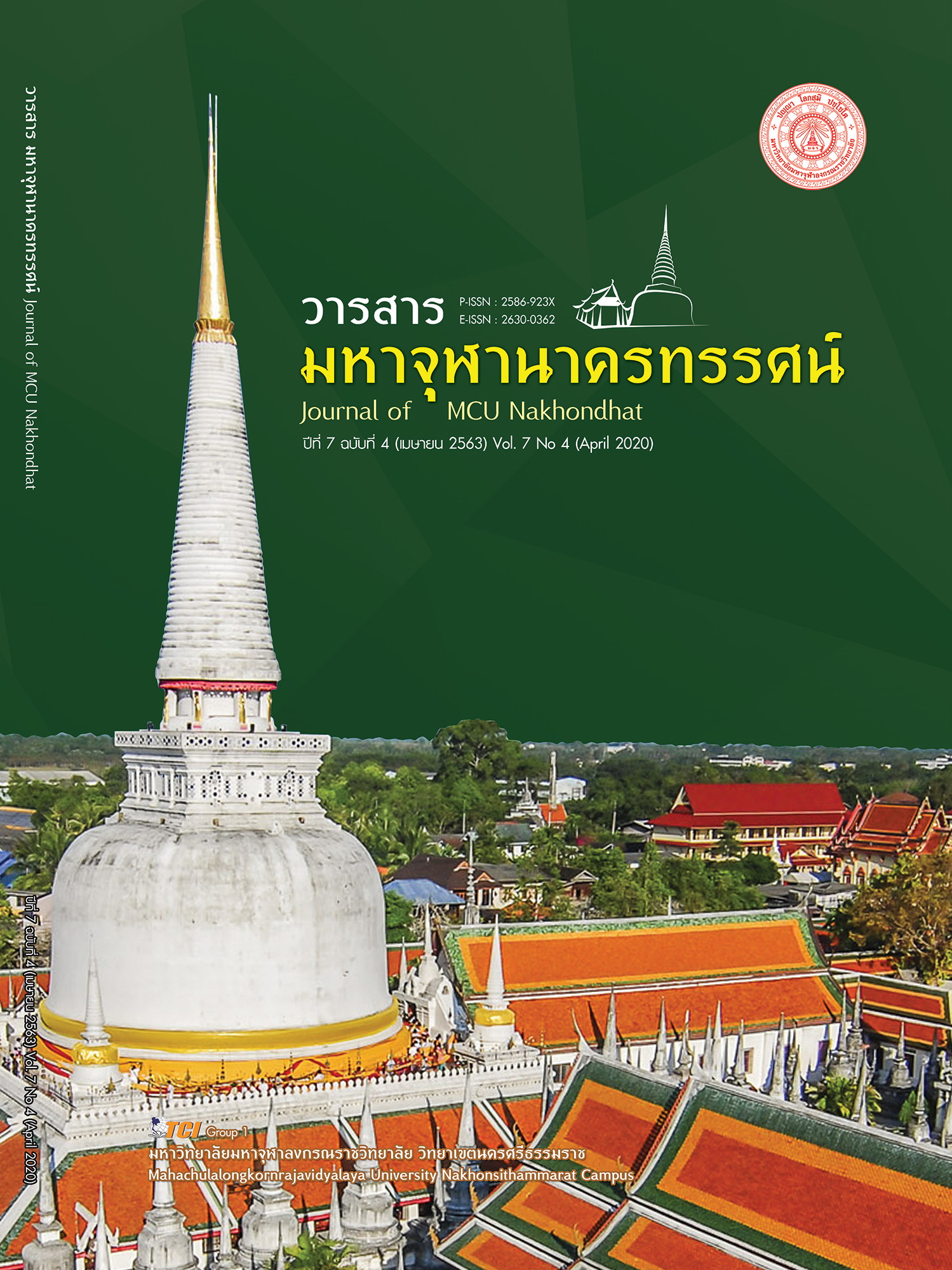THE ETHICAL VALUE OF VIPASSANA – BHAVANA TEACHING OF CHAYNA TEMPLE, NAKHON SI THAMMARAT PROVINCE IN THE CURRENT SOCIETY
Main Article Content
Abstract
This thesis entitled ‘Ethical values of teaching insight development of Watchaina, Nakhon Si Thammarat Province, in the present society’ has three objectives: 1) to study insight development as appeared in Buddhist scriptures, 2) to study insight development of Watchaina, Nakhon Si Thammarat province, and 3) to study the ethical values of teaching insight development of Watchaina, Nakhon Si Thammarat province in the present society. This is a qualitative research. In – depth interview was the research tool and data were analyzed through descriptive method.
In the research, it was found that: the insight development as appeared in Buddhist scriptures is purposely assigned to be the tool being applied in the practical method of insight development where the development of wisdom is expected to achieve by which three common characteristics can be seen. According to Watchaina, when it comes to such insight development, mindfulness on breathing is prescribed. In this respect, the ethical values produced by Watchaina are of the following levels: 1) individual level; by virtue of this, it gives rise to the calm, happiness, purity of mind, loving kindness, forgiveness, and controlling of one’s own emotion, 2) social and national level; it gives rise to the strong structure of the country where people gain bodily and mental healthiness where they can well adjust themselves to the worldly changes, 3) organizational and governmental level; it brings about the mental wellbeing where the indicator of man’s happiness and quality is expectedly put and that could create the greatest benefit based on the power of the concentration to people’s ways of life whereby the country could be led to various progressiveness, and 4) worldly level; it supports people meet their peaceful happiness where the inequality is gradually reduced. It is said that the centre of the worldly concentration is symbolized through the energy, harmony, physical and mental peace by which human beings can put an end to suffering together.
Article Details
References
พระครูภาวนากิจสุนทร. (2562). ศึกษารูปแบบและกระบวนการสอนวิปัสสนากัมมัฎฐาน ในจังหวัดนครศรีธรรมราช. วารสารมหาจุฬานาครทรรศน์, 6(3), 1586-1602.
พระธรรมปิฎก (ป.อ.ปยุตฺโต). (2543). พุทธธรรมฉบับปรับปรุงและขยายความ. (พิมพ์ครั้งที่ 9). กรุงเทพมหานคร: โรงเพิมพ์มหาจุฬาลงกรณราชวิทยาลัย.
พระศรีธีรวงศ์ (สมัย สจฺจวโร). (2553). ศึกษาภยญาณ ในการปฏิบัติวิปัสสนาตามหลัก สติปัฏฐาน 4: เฉพาะกรณีการปฏิบัติวิปัสสนา 7 เดือน. ใน วิทยานิพนธ์พุทธศาสตรมหาบัณฑิต สาขาวิชาพระพุทธศาสนา. มหาจุฬาลงกรณราชวิทยาลัย.
พระศรีวรญาณ (วิ). (2541). มารู้จักวิปัสสนากัมมัฏฐานสายพองหนอ ยุบหนอ. กรุงเทพมหานคร: บริษัทสหธรรมิก.
มหาจุฬาลงกรณราชวิทยาลัย. (2539). พระไตรปิฎกภาษาไทย ฉบับมหาจุฬาลงกรณราชวิทยาลัย. กรุงเทพมหานคร: โรงพิมพ์มหาจุฬาลงกรณราชวิทยาลัย.
มูลนิธิหลวงพ่อสดธรรมกายาราม. (2553). คู่มือปฏิบัติสมถวิปัสสนากัมมัฏฐาน 5 สาย, พุทโธ, อานาปานสติพอง - ยุบ,รูปนาม, สัมาอะระหัง. (พิมพ์ครั้งที่ 2). นครปฐม: บริษัท เพชรเกษม พริ้นติ้ง กรุ๊ป จํากัด.


